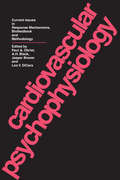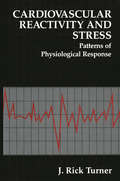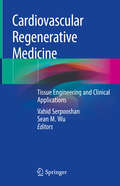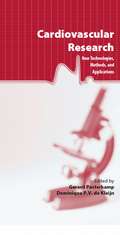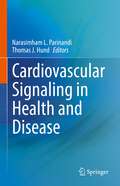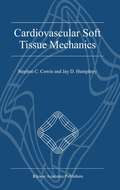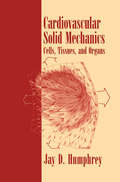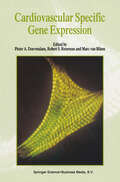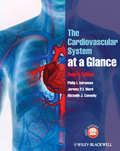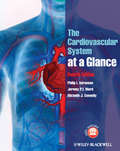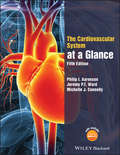- Table View
- List View
Cardiovascular Problems in Emergency Medicine: A Discussion-based Review (Current Topics in Emergency Medicine #2)
by Shamai A. Grossman Peter RosenA unique textbook in cardiovascular emergencies Cardiovascular Problems in Emergency Medicine takes you on rounds with the leading teachers of emergency medicine. Transcripts of in-depth telephone conferences on 27 real-life cardiovascular cases provide a unique and fascinating insight into the way complex cases are diagnosed and managed by some of the most experienced and respected practitioners in the field. Each chapter is then complemented by an authoritative, fully-referenced review of the current literature on the topic. With its unique approach, and the range of cases covered, Cardiovascular Problems in Emergency Medicine is an invaluable source of information for all emergency physicians, both qualified and in training.
Cardiovascular Psychophysiology: Current Issues in Response Mechanisms, Biofeedback and Methodology
by Paul A. Obrist A.H. Black Jasper Brener Leo V. DiCaraThe literature relating to the learned control of autonomic processes, especially cardiovascular processes demonstrating that the activities of visceral response systems may be modifi ed by operant reinforcement and biofeedback procedures, has grown exponentially. This research seems to show behavioral properties in the cardiovascular system that were previously believed to be exclusive attributes of the somatic response systems; the implications of this for possible therapeutic use have received widespread publicity. Questions remained unanswered-about the nature of "voluntary" control and the conditions necessary for establishing it, the reciprocal effects of conditioned changes in cardiovascular and psychological or behavioral functioning, the use of cardiovascular events to index behavioral states, and the principles and techniques whereby operant conditioning of the cardiovascular system can be clinically applied.
Cardiovascular Psychophysiology: Current Issues in Response Mechanisms, Biofeedback and Methodology
by Paul A. Obrist A.H. Black Jasper Brener Leo V. DiCaraThe literature relating to the learned control of autonomic processes, especially cardiovascular processes demonstrating that the activities of visceral response systems may be modifi ed by operant reinforcement and biofeedback procedures, has grown exponentially. This research seems to show behavioral properties in the cardiovascular system that were previously believed to be exclusive attributes of the somatic response systems; the implications of this for possible therapeutic use have received widespread publicity. Questions remained unanswered-about the nature of "voluntary" control and the conditions necessary for establishing it, the reciprocal effects of conditioned changes in cardiovascular and psychological or behavioral functioning, the use of cardiovascular events to index behavioral states, and the principles and techniques whereby operant conditioning of the cardiovascular system can be clinically applied.
Cardiovascular Reactivity and Stress: Patterns of Physiological Response (The Springer Series in Behavioral Psychophysiology and Medicine)
by J. Rick TurnerThis book is an articulate, concise, contemporary introduction to the study of important variables underlying cardiovascular reactivity. Its strength is in the combination of a scholarly but nonpedantic approach to cardiovascular psychophysiology and a solid understanding of be havioral medicine approaches to the study of hypertension. The topics covered are central to the study of relationships between behavior and cardiovascular reactivity; the list of suggested readings at the end of each chapter provides excellent guidance for more detailed study of specific issues. It has now been more than a dozen years since Plenum Press published Paul Obrist's seminal monograph Cardiovascular Psycho physiology. The volume had a major impact in relating cardiovascular regulation to behaving individuals and in developing thoughtful hy potheses concerning such factors as they might pertain to hypertension. The impact of that work extended across scientific disciplines as well as aross continents. At the time the Obrist book was published, a young psychologist, J. Rick Turner, was completing his Ph. D. thesis in psychol ogy at the University of Birmingham, England, on heart rate reactions to psychological challenge. After continued collaboration for the next several years with his former Ph. D. mentor, Douglas Carroll, Turner joined the Obrist laboratory at the University of North Carolina. Al though Obrist unfortunately died during Turner's tenure in the labora tory, collaboration continued with Kathleen Light and Andrew Sher wood. The enlightened legacy of the North Carolina laboratory can clearly be seen in this text.
Cardiovascular Regeneration and Stem Cell Therapy
by Annarosa Leri Piero Anversa William H. FrishmanThis book is the definitive reference on two of the most exciting areas of cardiovascular research – myocardial regeneration and stem cell therapy – for the treatment of disease. Edited by pioneers in the area, with contributions from every major investigator worldwide, it covers: The biology of stem cells The actions of stem cells from the bone marrow, the heart, and embryos on the normal restorative and repair functions of the heart and blood vessels How stem cells could contribute to myocardial recovery in the face of injury and aging How adjuvant therapy with growth factors might enhance stem cell activity in regeneration and repair Clinical applications and clinical experiences This fully referenced publication presents the current state of knowledge in both basic science and clinical practice, and is an essential reference for scientists, students, and clinicians.
Cardiovascular Regeneration Therapies Using Tissue Engineering Approaches
by Hidezo Mori Hikaru MatsudaThe cardiovascular system transports oxygen and nutrients to all parts of the body; therefore, any impediment to this system through, for example, a circulatory disorder, represents a serious threat to organs, tissues, and cells. Obstructive diseases of vessels with a diameter of more than 1 mm can be treated by conventional surgical and interventional approaches; however, blockages in small vessels with a diameter of less than 1 mm cannot be treated by conventional methods. As a consequence, therapeutic ang- genesis and vasculogenesis for the treatment of ischemic diseases have been widely studied in the last decade. These methods may contribute to the re pair of intractable cardiovascular diseases with a main vascular involvement in the body's smallest vessels. In this book, Hikaru Matsuda and I have tried to summarize recent Japanese developments in the field of cardiovascular regeneration therapies using tissue engineering. The Ministry of Health, Labor, and Welfare of Japan has been encouraging the National Cardiovascular Center Research Institute to promote cardiovascular regeneration therapies using such ap proaches. Therefore, it is with the financial aid and support of research grants, such as that for Cardiovascular Disease (13C-1 and I6C-6), Health and Labor Sciences Research Grants (RHGTEFB-genome-005, RHGTEFB-saisei-003, and CRCD-junkanki-009) and a grant from NEDO of Japan, that significant progress has been possible.
Cardiovascular Regenerative Medicine: Tissue Engineering and Clinical Applications
by Vahid Serpooshan Sean M. WuThis book is a comprehensive and up-to-date resource on the use of regenerative medicine for the treatment of cardiovascular disease. It provides a much-needed review of the rapid development and evolution of bio-fabrication techniques to engineer cardiovascular tissues as well as their use in clinical settings. The book incorporates recent advances in the biology, biomaterial design, and manufacturing of bioengineered cardiovascular tissue with their clinical applications to bridge the basic sciences to current and future cardiovascular treatment. The book begins with an examination of state-of-the-art cellular, biomaterial, and macromolecular technologies for the repair and regeneration of diseased heart tissue. It discusses advances in nanotechnology and bioengineering of cardiac microtissues using acoustic assembly. Subsequent chapters explore the clinical applications and translational potential of current technologies such as cardiac patch-based treatments, cell-based regenerative therapies, and injectable hydrogels. The book examines how these methodologies are used to treat a variety of cardiovascular diseases including myocardial infarction, congenital heart disease, and ischemic heart injuries. Finally, the volume concludes with a summary of the most prominent challenges and perspectives on the field of cardiovascular tissue engineering and clinical cardiovascular regenerative medicine.Cardiovascular Regenerative Medicine is an essential resource for physicians, residents, fellows, and medical students in cardiology and cardiovascular regeneration as well as clinical and basic researchers in bioengineering, nanomaterial and technology, and cardiovascular biology.
Cardiovascular Research: New Technologies, Methods, and Applications
by Gerard Pasterkamp Dominique De KleijnIn the last decade, technical improvements have changed the inventory of many research laboratories. New techniques and discoveries continuously give rise to observations that result in the de?nition of new research objectives. In the past, - search departments were clearly demarcated. Nowadays, technology that is shared by all lines of research stimulates convergence of research interests. This also - plies to cardiovascular research. Vascular occlusive disease is now core business for researchers employed by cardiology, vascular surgery, vascular medicine, - diology, cell biology, chemistry, physiology, and many other areas. Knowledge on actual research development is shared by researchers with different skills. It is sometimes dif?cult to acquire expertise when a researcher feels his experimental work could be improved by introducing a new research technique. In this book, the investigator will ?nd an overview of recent developments that are relevant for research in general but cardiovascular research in particular. Genomics, p- teomics, microarray, RNAi, stem cells, and progenitor cells are just some phrases that have become increasingly prevalent in literature in the last few years and that are recognized by many, but are fully understood by few. In this book, experts share the most appreciated new developments and techniques in cardiovascular research. We hope that this book will help the reader who is working in the ?eld of cardiovascular research to understand and critically appreciate current research, and that it will help improve the quality of experimental work. Dr G.
Cardiovascular, Respiratory, ENT & Eyes: Prepare for the MRCPCH. Key Articles from the Paediatrics & Child Health journal
by Will Carroll MD FRCPCHCardiovascular, Respiratory, ENT & Eyes is a new e-book in a collection of subject-themed e-books containing relevant key articles from Paediatrics & Child Health. The e-books provide a perfect source of revision for post-graduate exams in paediatrics and portfolio material for life-long learning. As well as mapping to the requirements of post-graduate training in paediatrics, these e-books also enable anyone with a short-term interest in a specific area to buy individual articles at a price-point that will give affordable access to all readers (from medical students to GPs and practitioners in related areas). The quality of user experience on mobiles, tablets and laptops will be an added bonus for learning on the move. About the journal The parent journal (http://www.paediatricsandchildhealthjournal.co.uk/) is a rolling, continuously updated review of clinical medicine over a 4-year cycle covering all the important topics for post-graduate exams in paediatrics. The journal’s articles are refreshed, updated, augmented or replaced as appropriate each time the subject is due for revision to provide a concise overview of knowledge and practice core to the curriculum. Each article is written by invited experts and overseen by the relevant subject specialist on the Board. A trainee representative on the Board ensures relevance and accessibility for exam candidates.
Cardiovascular Risk Assessment in Primary Prevention (Contemporary Cardiology)
by Michael D. ShapiroThis book is the first comprehensive text dedicated to risk assessment in the primary prevention of atherosclerotic cardiovascular disease. It provides an overview of current evidence regarding approaches to risk assessment, traditional and emerging risk factors, and atherosclerosis imaging for refinement of risk estimation. The volume seeks to provide an essential resource for professionals in the field to assess their patients for risk of cardiovascular disease. The book is divided into five sections, starting off with an overview of current best practices to risk assessment in primary prevention around the world. The second section discusses traditional risk factors, such as hypercholesterolemia, hypertension, diabetes, smoking, and obesity. The third section reviews the newly introduced concept of ‘Risk Enhancers’. The fourth section offers insight on novel risk factors, with in-depth discussion regarding lipoprotein(a), high-sensitivity CRP, apolipoprotein B, social determinants of health, stress and cardiovascular disease. and polygenic risk scores. The final section covers the use of non-invasive atherosclerosis imaging (computed tomography and ultrasound-based techniques) as a tool to refine risk estimates. Throughout the book, readers will find multiple tables, figures, and illustrations that complement the text. Up-to-date, evidence-based, and clinically oriented, Cardiovascular Risk Assessment in Primary Prevention is a must-have resource for physicians, residents, fellows, and medical students in cardiology, endocrinology, primary care, and health promotion and disease prevention.
Cardiovascular Risk in Type 2 Diabetes Mellitus: Assessment and Control
by NicolaeHâncuA lot of time has been spent trying to convince health care providers and policy makers of the enormous importance of macrovascular disease in persons with type 2 diabetes. In this volume, we present facts that dem onstrate how important it is to recognize macrovascular disease in these patients in daily practice. This volume has been compiled to help those already involved in dia betes care, to be more involved in cardiovascular risk control, a task that is not easily achieved. The area of cardiovascular risk in type 2 diabetes is heterogeneous. Trying to characterize it, we can only say: certainly we know more than we do, but for sure we do less than we could. Our challenge is to change this. Nicolae Htmcu Professor N. Hancu was born in Romania in 1940. He studied medicine at the Iuliu Hatieganu University of Medicine and Pharmacy, Cluj-Napoca, and obtained his speciality in internal medicine in 1970, and in diabetes, nutrition and metabolic disease in 1986. He was appointed Professor and Head of the Department of Diabetes, Nutrition and Metabolic Diseases of the same university in 1993. He has been a full member of the Romanian Academy of Medical Sciences since 1995. Professor Hancu's major interest is related to clinical lipidology, visceral obesity, and cardiovascular risk in type 2 diabetes. He has published over 200 papers and 14 books in this area. He has been invited as Visiting Professor at many universities in Madrid, Valladolid, Barcelona, and Los Angeles.
Cardiovascular Risk Management
by Richard Hobbs Bruce ArrollPractical ABC style Enables doctors to prioritise treatment using risk-scoring systems and holistic recommendations for reducing cardiovascular risk Includes treatment plans for individuals with diabetes, who are at high risk of developing cardiovascular disease How to reduce cardiovascular risk in other specific patient groups Developed by expert groups in different regions of the world
Cardiovascular Safety in Drug Development and Therapeutic Use: New Methodologies and Evolving Regulatory Landscapes
by J. Rick Turner Dilip R. Karnad Snehal KothariAt a time when the field of cardiac safety is going through important changes, this unique book provides the rationale for, and cutting-edge explanations of, new regulatory landscapes that will likely govern cardiac safety assessments globally for the foreseeable future. Exposure-response modeling is already being accepted by regulatory agencies in lieu of the traditional Thorough QT/QTc Study, and the Comprehensive in vitro Proarrhythmia Assay initiative is well under way. Developments in the field of cardiovascular safety are also described and discussed in the book. These include the search for more efficient ways to exonerate new drugs for type 2 diabetes from an unacceptable cardiovascular liability, how best to address off-target blood pressure increases induced by noncardiovascular drugs, and the continued evolution of the discipline of Cardio-oncology.“a resource that will likely serve as a standard for years to come” - Dr Jonathan SeltzerTherapeutic Innovation & Regulatory Science, 2017;51(2):180“I have no hesitation in recommending this book as a valuable reference source” - Dr Rashmi ShahJournal for Clinical Studies, 2017;9(1):62-63
Cardiovascular Signaling in Health and Disease
by Narasimham L. Parinandi Thomas J. HundThis contributed volume focuses on cardiovascular diseases (CVDs), and explores the ways in which signaling mechanisms at the biochemical, molecular, and cellular levels in the blood vessels (vascular) and heart contribute to the underlying causes of development and progression of the CVDs. This volume covers unique topics such as oxidant signaling in vascular and heart diseases and health, cytoskeletal signaling in vascular health and disease, phospholipase signaling in CVDs, lipid signaling in vascular and myocardial health and diseases, and drug discovery in cellular signaling for cardiovascular diseases.This book assembles the most important discoveries made by leaders on the cellular signaling mechanisms operating behind the development and progression of life-threatening CVDs. It is an extremely useful resource for the investigators in the field of CVDs, and opens the discussion for further discovery of efficient management and effective treatment of the CVDs.
Cardiovascular Soft Tissue Mechanics
by Stephen C. Cowin Jay D. HumphreyThis special volume of the Journal of Elasticity represents the first in a new p- gram dedicated to the occasional publication of collections of invited, reviewed papers of topical interest. The purpose of this program is to spotlight the dev- opments and applications in the mechanics of materials within specific areas that can enhance growth and provide insight for the advancement of the field as well as promote fundamental understanding and basic discovery. Soft Tissue Mechanics is an area of biomechanics that draws heavily upon f- damental ideas and material models from nonlinear elasticity and viscoelasticity. A major goal of this research is to understand those mechanics properties of heart, artery, collagen and skeletal muscle tissue that can be used for the diagnosis of health problems and the improvement of human life. This volume illustrates how experiment, modeling and computation is currently employed in this emerging field. May 2001 ROGER FOSDICK Editor-in-Chief Journal of Elasticity 61: ix–xii, 2000. ix Preface There are two primary areas for the application of elasticity in the biomechanics of tissues: hard tissue mechanics (e.g., bone, teeth, horns, etc.) and soft tissue - chanics (e.g., skin, tendons, arteries, etc.). The distinguishing feature between these tissue types is the amount of physiological “normal” deformation they experience. While “hard” tissues only experience small deformations, soft tissues typically experience large deformations. From a biomechanics viewpoint soft tissues fall within the realm of finite elasticity.
Cardiovascular Solid Mechanics: Cells, Tissues, and Organs
by Jay D. HumphreyThis text presents a general introduction to soft tissue biomechanics. One of its primary goals is to introduce basic analytical, experimental and computational methods. In doing so, it enables readers to gain a relatively complete understanding of the biomechanics of the heart and vasculature.
Cardiovascular Specific Gene Expression (Developments in Cardiovascular Medicine #214)
by Pieter A. Doevendans Robert S. Reneman Marc Van BilsenImproving our insights into the genetic predisposition to cardiovascular disease is one of the most important challenges in our field in the next millennium, not only to unravel the cause of disease but also to improve the selection of patients for particular treatments. Nowadays, for example, subjects with a cholesterol above a particular plasma level are exposed to a cholesterol lowering regime based upon the beneficial outcome of epidemiological studies which include subjects not prone to the disease, despite a plasma cholesterol above the accepted level. Identification of the patients who are genetically predisposed to the consequences of this disorder will reduce the number of subjects unnecessarily treated and, hence, the costs of health care. Because in most cardiovascular diseases the genetic component is a consequence of more than one gene defect, only limited progress has as yet been made in identifying subjects genetically at risk. For example, in hypertension only in less than 10% of the patients the genetic defect has been identified. It has been known for quite some time that in heart and blood vessels fetal genes are as high blood pressure and upregulated or induced when they are exposed to such disorders ischemia. Little is known about the function of these genes in the cardiac and vascular adaptation to these disorders; only guesses can be made.
Cardiovascular Surgery: A Clinical Casebook
by Fabio Biscegli Jatene Rui Manuel AlmeidaThis clinical casebook is comprised of surgical cases involving the most important cardiovascular diseases in a concise, easy-to-read format (5x8 in trim size, like other titles in this burgeoning, informal product line in the Springer clinical medicine program).Each chapter is a case that opens with a unique clinical presentation, followed by a description of the diagnosis, assessment and management techniques used to treat it, as well as questions and answers (between 8 and 10) about relevant aspects related to the diagnosis and treatment of the addressed disease. The Q&A section will broaden discussion and increase the title's pedagogical value. The casebook features 40 surgical cases in the following thematic areas: Aortic Disease, Arrhythmias, Cardiac Tumors, Coronary Insufficiency, Congenital Heart Disease, Endovascular Therapies, Heart Failure, Heart Transplantation, Mechanical Circulatory Support, Pericardial Disease, Pulmonary Embolism and Valvular Heart Disease. This book will be prepared by the Brazilian Department for Academic Leagues of Cardiovascular Surgery, within the Brazilian Society of Cardiovascular Surgery (BSCVS). This department is the section within BSCVS that consists of the academic leagues of cardiovascular surgery from each university throughout the country. In Brazil, medical academic leagues are organizations that gathers students, interns and residents to discuss a certain topic and promote research and teaching-oriented extra-class activities, supervised by a group of professors. Thus trainees will have involvement in writing the chapters and the senior professor supervisors will edit and finalize the work. Basically, each chapter is written by an intern or resident and, ultimately, his/her supervisor. As the books volume editors, doctors Almeida and Jatene will have final responsibility for the cases and overall manuscript.
Cardiovascular Surgery 1980: Proceedings of the 29th International Congress of the European Society of Cardiovascular Surgery
by H. D. Schulte J. Ostermeyer W. BircksThe Cardiovascular System at a Glance (At a Glance)
by Philip I. Aaronson Jeremy P. Ward Michelle J. ConnollyThis concise and accessible text provides an integrated overview of the cardiovascular system - considering the basic sciences which underpin the system and applying this knowledge to clinical practice and therapeutics. A general introduction to the cardiovascular system is followed by chapters on key topics such as anatomy and histology, blood and body fluids, biochemistry, excitation-contraction coupling, form and function, integration and regulation, pathology and therapeutics, clinical examination and investigation - all supported by clinical cases for self-assessment. Highly visual colour illustrations complement the text and consolidate learning.The Cardiovascular System at a Glance is the perfect introduction and revision aid to understanding the heart and circulation and now also features: An additional chapter on pulmonary hypertension Even more simplified illustrations to aid easier understanding Reorganized and revised chapters for greater clarity Brand new and updated clinical case studies illustrating clinical relevance and for self-assessment The fourth edition of The Cardiovascular System at a Glance is an ideal resource for medical students, whilst students of other health professions and specialist cardiology nurses will also find it invaluable. Examination candidates who need an authoritative, concise, and clinically relevant guide to the cardiovascular system will find it extremely useful.A companion website featuring cases from this and previous editions, along with additional summary revision aids, is available at www.ataglanceseries.com/cardiovascular.
The Cardiovascular System at a Glance (At a Glance)
by Philip I. Aaronson Jeremy P. Ward Michelle J. ConnollyThis concise and accessible text provides an integrated overview of the cardiovascular system - considering the basic sciences which underpin the system and applying this knowledge to clinical practice and therapeutics. A general introduction to the cardiovascular system is followed by chapters on key topics such as anatomy and histology, blood and body fluids, biochemistry, excitation-contraction coupling, form and function, integration and regulation, pathology and therapeutics, clinical examination and investigation - all supported by clinical cases for self-assessment. Highly visual colour illustrations complement the text and consolidate learning.The Cardiovascular System at a Glance is the perfect introduction and revision aid to understanding the heart and circulation and now also features: An additional chapter on pulmonary hypertension Even more simplified illustrations to aid easier understanding Reorganized and revised chapters for greater clarity Brand new and updated clinical case studies illustrating clinical relevance and for self-assessment The fourth edition of The Cardiovascular System at a Glance is an ideal resource for medical students, whilst students of other health professions and specialist cardiology nurses will also find it invaluable. Examination candidates who need an authoritative, concise, and clinically relevant guide to the cardiovascular system will find it extremely useful.A companion website featuring cases from this and previous editions, along with additional summary revision aids, is available at www.ataglanceseries.com/cardiovascular.
The Cardiovascular System at a Glance (At a Glance)
by Philip I. Aaronson Jeremy P. Ward Michelle J. ConnollyEverything you need to know about the cardiovascular system... at a Glance! The Cardiovascular System at a Glance is the essential reference guide to understanding all things circulatory. Concise, accessible, and highly illustrated, this latest edition presents an integrated overview of the subject, from the basics through to application. Featuring brand new content on stroke, examination and imaging, heart block and ECGs, and myopathies and channelopathies, The Cardiovascular System at a Glance goes one step further and offers new and updated clinical case studies and multiple-choice questions on a supplementary website. Integrates basic science and clinical topics Offers bite-size chapters that make topics easy to digest Includes coverage of anatomy and histology, blood and haemostasis, cellular physiology, form and function, regulation and integration of cardiovascular function, history, examination and investigations, pathology and therapeutics Filled with highly visual, colour illustrations that enhance the text and help reinforce learning The fifth edition of The Cardiovascular System at a Glance is an ideal resource for medical students, junior doctors, students of other health professions, and specialist cardiology nurses.
The Cardiovascular System at a Glance (At a Glance)
by Philip I. Aaronson Jeremy P. Ward Michelle J. ConnollyEverything you need to know about the cardiovascular system... at a Glance! The Cardiovascular System at a Glance is the essential reference guide to understanding all things circulatory. Concise, accessible, and highly illustrated, this latest edition presents an integrated overview of the subject, from the basics through to application. Featuring brand new content on stroke, examination and imaging, heart block and ECGs, and myopathies and channelopathies, The Cardiovascular System at a Glance goes one step further and offers new and updated clinical case studies and multiple-choice questions on a supplementary website. Integrates basic science and clinical topics Offers bite-size chapters that make topics easy to digest Includes coverage of anatomy and histology, blood and haemostasis, cellular physiology, form and function, regulation and integration of cardiovascular function, history, examination and investigations, pathology and therapeutics Filled with highly visual, colour illustrations that enhance the text and help reinforce learning The fifth edition of The Cardiovascular System at a Glance is an ideal resource for medical students, junior doctors, students of other health professions, and specialist cardiology nurses.
The Cardiovascular System E-Book: Systems of the Body Series (Systems of the Body)
by Alan Noble Robert Johnson Alan Thomas Paul BassThis is an integrated textbook on the cardiovascular system, covering the anatomy, physiology and biochemistry of the system, all presented in a clinically relevant context appropriate for the first two years of the medical student course.One of the seven volumes in the Systems of the Body series.Concise text covers the core anatomy, physiology and biochemistry in an integrated manner as required by system- and problem-based medical courses.The basic science is presented in the clinical context in a way appropriate for the early part of the medical course.There is a linked website providing self-assessment material ideal for examination preparation.

